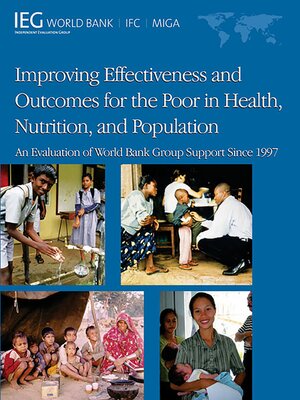Improving Effectiveness and Outcomes for the Poor in Health, Nutrition, and Population
ebook ∣ An Evaluation of World Bank Group Support Since 1997 · Independent Evaluation Group Studies
By World Bank

Sign up to save your library
With an OverDrive account, you can save your favorite libraries for at-a-glance information about availability. Find out more about OverDrive accounts.
Find this title in Libby, the library reading app by OverDrive.



Search for a digital library with this title
Title found at these libraries:
| Library Name | Distance |
|---|---|
| Loading... |
This study evaluates the effectiveness of the World Bank Group's support for health, nutrition, and population (HNP) in developing countries from 1997 to 2008 – totaling more than $17 billion – and distills lessons for greater impact in the future. It finds that the Bank Group now funds a smaller share of global support for HNP than a decade ago, but its support remains substantial and adds considerable value. About two-thirds of the Bank's HNP support has had satisfactory outcomes, often in difficult environments. But in a number of country settings, particularly in Africa, it has not performed well, in part due to high complexity and weak capacity. Only half of HNP support had a pro-poor focus, while support to reduce high fertility and promote family planning has dwindled. The evaluation highlights the contribution of investments in water supply, sanitation, and hygiene to improving the health of the poor and the lessons from support for sector-wide approaches, communicable disease control, and health reform. Moving forward, the World Bank needs to improve the performance of its HNP support and the Bank and IFC need to take actions to ensure their support reaches the poor and contributes greater social benefits, respectively.







